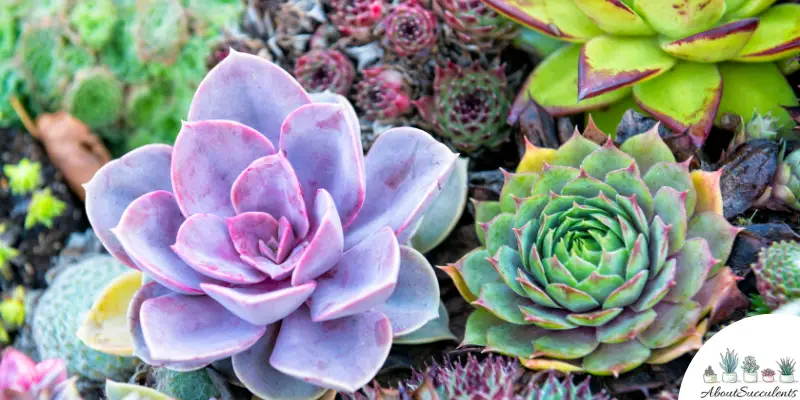
Succulents are plants that evolved to survive in their environment. In the process of adaptation, succulents developed characteristics that allowed them to thrive in harsh conditions and acquire features that make them resplendent centerpieces in an outdoor garden.
To survive dry and arid conditions, succulents evolved to store water in their leaves, stems, and roots. Other factors such as exposure to sunlight, type of soil, rainfall, and temperature contributed to succulent plants developing eye-catching attributes in color, texture, and shape that are unique to their family.
Succulent Garden Ideas And How To Plant Them
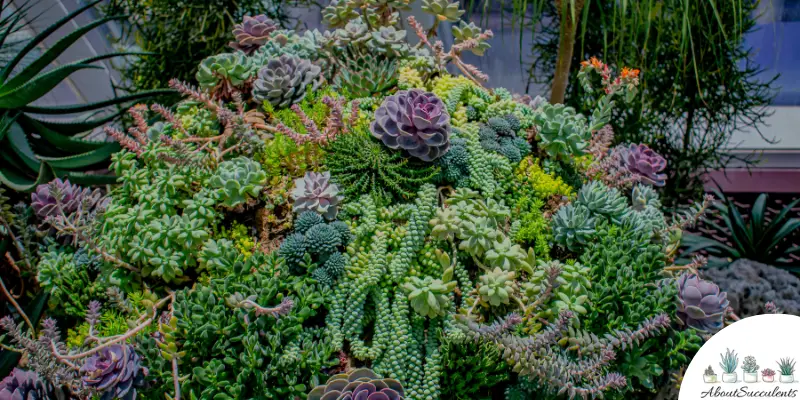
Succulents have become popular in recent years not only because of their charm and allure but because they are easy to grow and care for. Likewise, succulents are highly durable and have built a reputation as “hard to kill” plants.
However, it’s the physical appearance of the succulents that initially draw people to these plants. Succulents come in all colors, sizes, shapes, and with their own identifiable qualities.
The mesmerizing and captivating beauty of succulents is sure to draw attention from your guests as well as from onlookers and passers-by. For this reason, you can find succulent arrangements in the hotel lobby, the powder room, an office, at weddings, home entrances, and outdoor patios.
Succulents are commonly planted on the ground in an outdoor garden or in pots that can be readily moved indoors when weather conditions turn frosty. But with a little bit of imagination, there are a few other ways you can highlight the distinct aesthetics and properties of your succulent plants.
Ground Cover
Sedums are a variety of succulents that spread or creep outward and are used as ground cover for areas in the outdoor garden that look dry and lifeless.
Another succulent that’s popularly grown as ground cover is Calandrinia spectabilis or Rock Purslane because it becomes a thick, green mound that blooms beautiful magenta flowers in the fall.
Hanging Containers
Burro’s Tail and String of Buttons are a few examples of trailing succulents that are planted inside hanging container baskets. When their leaves have stretched out and descended, they give the impression of a cascading and colorful waterfall.
You can also use hanging dish containers with shallow bottoms to display trailing succulent types such as Crassula, Sempervivum, and Aeonium. Use dish containers with different colors and turn them into attractive bird feeders.
Container Arrangements
Planting succulents in containers will give your imagination more room to grow. Arrange succulents according to height to give your outdoor garden a semblance of layer and structure.
Plant small echeverias of various colors in tapered terracotta pots outside your window water box for Instagram-worthy snapshots from onlookers. In fact, you can do the same with trailing succulents to create a cascading waterfall effect outside your window.
Rock Garden
A rock garden is a great way to elicit “wows” from your guests. Landscapers create a rock garden to bring texture, depth, and dimension to empty spaces.
Succulents are added in rock gardens as ground cover, as accents when planted in containers or to create an illusion of vertical height.
Landscapers might also use rocks and stones as steps leading to the patio or activity area. You can insert dark green-colored echeverias combined with Crassula ovata succulents with red-colored leaves between the steps to create a nice contrast of colors and textures.
The possibilities seem endless when it comes to planting succulents outdoors. With so many varieties to choose from the challenge is how to mix and match succulents for your garden.
Design For Succulents In A Garden
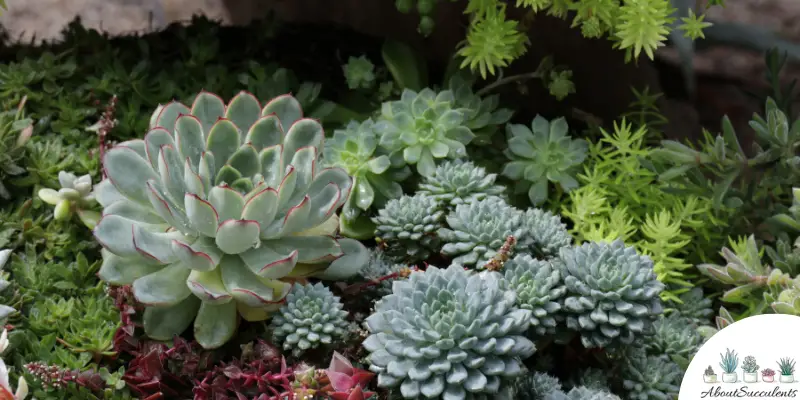
Succulents are popularly referred to as cacti. And while all cacti are succulents, not all succulents are cacti. Those that belong to the Cactaceae family feature rounded indentations along the stems called “areoles” from where its most identifiable trait – the spines – springs forth.
There are other varieties of succulents that have distinctive qualities such as thick and fleshy paddle-shaped leaves, cabbage-like compact rosettes on top of stalks, and felted leaves with flowers with a range of colors encompassing an entire box of crayons.
If you visit a garden store or nursery, you might get overwhelmed by the number of varieties of succulents to choose from. How do you know which ones to buy for your outdoor garden?
Colors For Continuity
You can choose succulents that have different hues of the same color in order to create subtle contrast and definition in your garden.
For example, you can mix and match agaves with a darker shade like the Agave victoria -reginae or Agave Queen Victoria or Agave Parviflora with a yucca succulent such as the Yucca Rupicola or Twisted Yucca that has bright-green colored leaves.
Texture Creates Illusion
An aggressive grower, Anigozanthos or Big Red Kangaroo Paw can present your garden with rows of fan-like stalks where you will find large, tubular-shaped, red-colored flowers that are covered by velvety fuzz.
You can match Big Red Kangaroo with another succulent that can give your outdoor garden the illusion of shimmering such as the elegant Yucca rostrata or Beaked Yucca.
Yucca rostrata is sought for its shimmering rosette that’s set on top of a tree trunk with a cascade of old leaves. This handsome succulent gives you the impression of a fireworks display of dark green explosions against the backdrop of fuzzy Big Red Kangaroo Paw and the light blue sky.
Choose Succulents of Varying Sizes
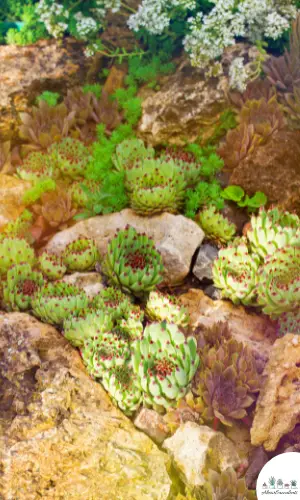
Layering is a popular technique of landscape artists to create volume and depth in an outdoor garden. The easiest way to do this is to choose succulents of varying heights or sizes.
For example, you can put Euphorbia tirucalli or Sticks on Fire, a type of succulent that grows up to 8 feet (2.4m) and produces a thicket of bright, vibrant red to orange stems that spread out and grow vertically in the backdrop of your outdoor garden.
In the center area, you can grow medium-sized succulents such as Echinocactus grusonii or Golden Barrel Cactus that reach a height of 2 feet (0.609m) and a low-growing succulent like Senecio mandraliscae or Blue chalk sticks right upfront.
Sunlight Needs
Your outdoor garden will have areas that receive partial and full sunlight. A good idea would be to plant succulents that thrive in these locations.
Succulents that prefer low or partial light include Aloe Vera, Jade Plant, Zebra Plant, Gasteria, Haworthia, and Kalanchoe. Succulents that need direct sunlight to maximize their full beauty include Agave, Old Man Cactus, Sempervivum, Senecio Blue Chalkstick, Aeonium, Echeveria, and Sedum stonecrop.
Watering Needs
Succulents grow better with fewer watering schedules but there are varieties that need more water than others.
Drought-tolerant succulents that can survive an entire month without watering include Lithops, String of Pearls, Snake Plant, Aloe Vera, Ponytail Palm, Agave, Tulista Haworthia, and Tacipetalum Stardust.
In contrast succulents such as Rhipsalis cereuscula, Crassula arborescens undulatifolia or Ripple Jade, and Portulacaria afra variegata will grow better when receiving water every 10-14 days.
Requirements For A Beautiful Succulents Garden
If you want to become a horticulturist, starting out the hobby with succulents is a smart idea. You don’t need to spend a lot of time with them. In fact, it’s a better idea that you don’t hover over your succulents.
You only have to keep these 5 things in mind when planting succulents in an outdoor garden:
- Sunlight – Plant succulents in an area in the garden that gets 4 to 6 hours of morning sunlight every day.
As we previously discussed, there are types of succulents that need direct sunlight to bring out their full color but generally, avoid locations that will expose the succulents to the harsh rays of the afternoon sun.
- Water – Succulents already store plenty of water. Giving the soil water while it’s still moist will lead to root rot and eventually kill the plant. Only water the soil when it’s dry to the touch.
A good way to test the dryness of the soil is to insert a stick an inch deep. If the tip of the soil feels dry to the touch, then it’s ready to receive water. Always water the soil and never the plant itself. Make sure it gets a thorough soaking.
During summer you might find yourself watering the succulent every seven to 10 days and rarely in the winter months.
- Soil – Well-draining soil such as a commercial mix or sandy soil is best for succulents because these types of soil allow moisture to escape faster. Add pumice, lava rock, or coarse sand to further improve drainage.
Fertilizer is not necessary but won’t be harmful either. Best time to fertilize the soil is early spring or during the growing season and never more than once or twice a year.
- Pot – Planting outdoor succulents in a pot is a good idea if you live in a region that experiences cold, frosty weather. The best choice of pot is one that’s made of terracotta or unglazed ceramic which are both porous and facilitate moisture to escape along its sides.
- Pests – Succulents naturally attract pests such as mealybugs and aphids that feed on the sap. To keep pests away from your succulents, spray them with organic neem oil and remove dead leaves that have accumulated nearby.
If you see white, feathery substances on the leaves, these are the residue from mealybugs. Wipe these substances with a cotton ball soaked in 70% isopropyl alcohol.
Succulents Design And Decor
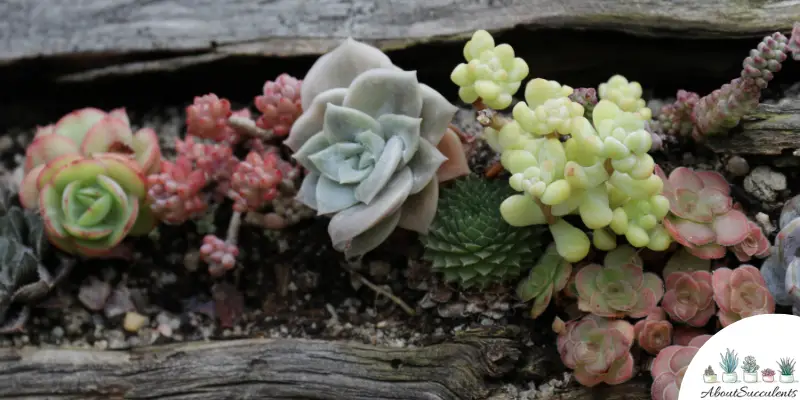
Succulents are beautiful by nature and add life, color, and excitement to any area they are displayed in. But a little embellishing can go a long way in making your succulent plants stand out even more.
Let’s start out with the pots where the succulents are planted in.
Choose ceramic or terracotta pots of different sizes and colors. House tall-growing succulents such as African Milk Tree, Snake Plant, and Fox Tail Agave in a pot that’s 10% larger than the plant itself. You can find exotic-looking pots that have unique textural designs.
Repurpose old furniture such as benches, spice racks, tables, chairs, and wooden shelves into display holders for trailing succulents or the smaller varieties planted in colorful pots.
You can spruce up your outdoor succulent garden by setting up a water display or a fountain near the patio or lounging area. As a bonus, fountains are known to attract songbirds.
Create the illusion of a running river by including a dry creek bed made of cobblestones that are slightly angled sideways.
Conclusion
Succulents can turn any garden from drab to fab without costing you much in terms of time and money. Nature made succulents durable but in the process rewarded their resiliency to the environment with a beguiling type of beauty that charms and delights onlookers.
As low-maintenance plants, it’s easy to understand why people quickly get enamored with succulents. As passion grows, so does creativity and the need to show love to their plants.
The time will come when you’ll sit back, realize, and marvel at how far you’ve come to building your outdoor succulent garden.
Last Updated on June 28, 2022 by Sofia Lara